7 Best Herbal Teas For Throat Pain
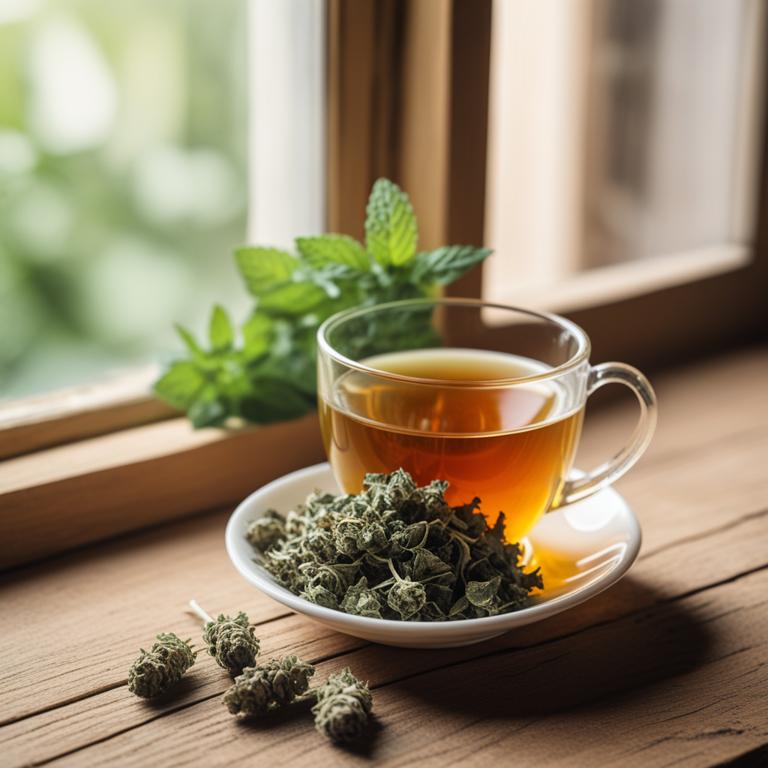
Herbal teas for Throat pain are natural remedies made from various plant-based ingredients that help soothe and alleviate discomfort in the throat.
These teas can treat Throat pain effectively because of their anti-inflammatory and antibacterial properties, which help reduce swelling and fight off infections.
Some popular herbal teas used to treat Throat pain include Slippery Elm, which forms a protective barrier on the mucous membranes, Ginger, which reduces inflammation and eases pain, Peppermint, which cools and soothes the throat, Echinacea, which boosts the immune system, and Thyme, which has antimicrobial properties to combat infections.
Additionally, Lemon and Honey, Licorice root, and Sage are also commonly used to treat Throat pain due to their soothing and anti-inflammatory effects.
Related Study
According to "Journal of alternative and complementary medicine (New York, N.Y.)", teas for throat pain, specifically Throat Coat herbal tea, have been shown to significantly reduce the intensity of throat pain when swallowing in patients with pharyngitis, providing rapid and temporary relief.
Below there's a list of the 7 best herbal teas for throat pain.
Table of Contents
Also, you may be interested in...
Today Free Bonus!
The Ultimate Herb Drying Checklist
(For Long-Lasting Powerful Medicinal Effect)
How to easily dry herbs that don't mold and that keep their strong medicinal power for more than 1 year.
1. Echinacea purpurea teas
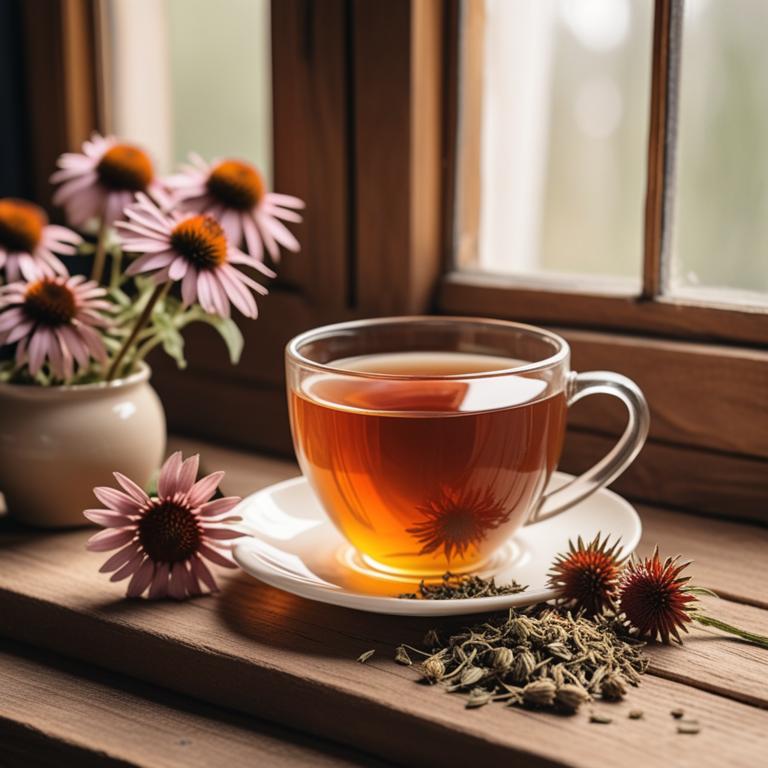
Echinacea purpurea teas have been traditionally used to treat throat pain and other respiratory issues due to their anti-inflammatory and immunomodulatory properties.
The bioactive constituents of Echinacea, such as alkylamides, glycoproteins, and polyphenols, help to stimulate the immune system and reduce inflammation, thereby alleviating throat pain and discomfort.
The benefits of Echinacea purpurea teas in treating throat pain include their ability to reduce the severity and duration of symptoms, as well as their antimicrobial properties that help to combat infections.
By incorporating Echinacea purpurea teas into their regimen, individuals can experience relief from throat pain and promote overall well-being.
Related Study
According to the information provided, Echinacea purpurea teas may be beneficial for throat pain due to the plant's potential as an adjuvant symptomatic therapy in respiratory conditions, such as the common cold and cough.
Recipe:
- Gather 1 cup of fresh or dried Echinacea purpurea flowers.
- Measure 1 tablespoon of the flowers and place them in a clean glass cup.
- Boil 1 cup of water in a kettle or on the stovetop.
- Pour the boiling water over the Echinacea flowers in the cup.
- Let the mixture steep for 5-7 minutes, then strain and drink.
Echinacea purpurea teas can be used to treat throat pain, but potential side effects may include stomach upset, allergic reactions, and interactions with other medications, particularly blood thinners and diabetes medications.
To minimize potential risks, it is essential to start with small doses, avoid using it for extended periods, and monitor for signs of allergic reactions, such as difficulty breathing or rapid heartbeat, when using Echinacea purpurea teas to treat throat pain.
Echinacea Purpurea Tea on Amazon
BLUE TEA - Chamomile Tea - Butterfly Pea Flower -18 Count - Pyramid Tea Bag | DETOX TEA | Caffeine Free - Flower Based - Vegan - Non-Bitter - Natural Ingredients | Tin Packaging
Disclaimer: We earn a commission if you click this link and make a purchase at no additional cost to you.
2. Glycyrrhiza glabra teas

Glycyrrhiza glabra teas, also known as licorice root tea, have been used for centuries to treat throat pain and other respiratory issues.
The anti-inflammatory and soothing properties of this herbal preparation help to reduce throat irritation and discomfort, providing relief from pain and inflammation.
The bioactive constituents of Glycyrrhiza glabra, including glycyrrhizin, flavonoids, and saponins, work together to exhibit their therapeutic effects, which include reducing inflammation, fighting off infections, and soothing the mucous membranes in the throat.
The benefits of using Glycyrrhiza glabra teas to treat throat pain include quick relief from pain and inflammation, reduced risk of complications, and a natural and non-addictive alternative to conventional medications.
Related Study
According to "Journal of the Medical Association of Thailand = Chotmaihet thangphaet", Glycyrrhiza glabra teas for throat pain showed strong antimicrobial activity against S. pyogenes ATCC 19615 with a minimal inhibitory concentration (MIC) value of 39 μg/ml and a minimal bactericidal concentration (MBC) value of 78 μg/ml.
Recipe:
- Gather 1 cup of fresh or dried Glycyrrhiza glabra roots. You can find them at a local health food store or online.
- Measure 2 tablespoons of the roots and place them in a heat-resistant cup or teapot.
- Pour 1 cup of boiling water over the roots. Let it steep for 5-7 minutes to allow the flavors to release.
- Strain the liquid using a fine-mesh sieve or cheesecloth to remove the roots. Discard the roots.
- Drink the tea warm or at room temperature, 2-3 times a day to help soothe throat pain.
Glycyrrhiza glabra teas can be used to treat throat pain, but possible side effects may include elevated blood pressure, low potassium levels, and an increased risk of heart problems due to its high glycyrrhetic acid content.
To use this herbal preparation safely, it is recommended to drink it in moderation, not consume it for extended periods, and monitor your blood pressure and potassium levels closely, especially if you have pre-existing heart or kidney conditions.
Glycyrrhiza Glabra Tea on Amazon
Pukka Herbal Teas Licorice and Cinnamon - 20 Bags, 20 Count
Disclaimer: We earn a commission if you click this link and make a purchase at no additional cost to you.
3. Zingiber officinale teas

Zingiber officinale teas, derived from the rhizome of the ginger plant, have been traditionally used to treat throat pain and other respiratory issues.
The anti-inflammatory and antimicrobial properties of this herbal preparation help to reduce pain and inflammation in the throat, promoting a speedy recovery.
The bioactive constituents of Zingiber officinale teas, including gingerols and shogaols, have been shown to exhibit analgesic and anti-inflammatory effects, making it an effective remedy for throat pain.
The benefits of Zingiber officinale teas in treating throat pain include rapid relief from pain and inflammation, reduced risk of infection, and promotion of a healthy respiratory system.
Related Study
According to "Journal of ethnopharmacology", Zingiber officinale teas for throat pain may be effective due to the presence of lariciresinol, a compound that can inhibit efflux pumps in bacteria, thereby enhancing the potency of antibiotics and potentially alleviating throat infection symptoms.
Recipe:
- Boil 1 cup of water in a pot.
- Add 1 tablespoon of fresh ginger root, sliced, to the boiling water.
- Reduce heat and let it simmer for 5-7 minutes.
- Strain the tea into a cup using a fine-mesh sieve or cheesecloth.
- Add honey to taste, if needed, and drink while warm.
Zingiber officinale teas can provide relief from throat pain, but its use may cause stomach upset, nausea, and diarrhea in some individuals due to its spicy and warm nature.
When using Zingiber officinale teas to treat throat pain, it is essential to start with small amounts and gradually increase the dose to minimize the risk of stomach irritation and to avoid interactions with other medications, especially blood thinners and antacids.
Zingiber Officinale Tea on Amazon
FGO Organic Ginger Tea, 100 Count, Eco-Conscious Tea Bags, Caffeine Free, Packaging May Vary (Pack of 1)
Disclaimer: We earn a commission if you click this link and make a purchase at no additional cost to you.
4. Eucalyptus globulus teas
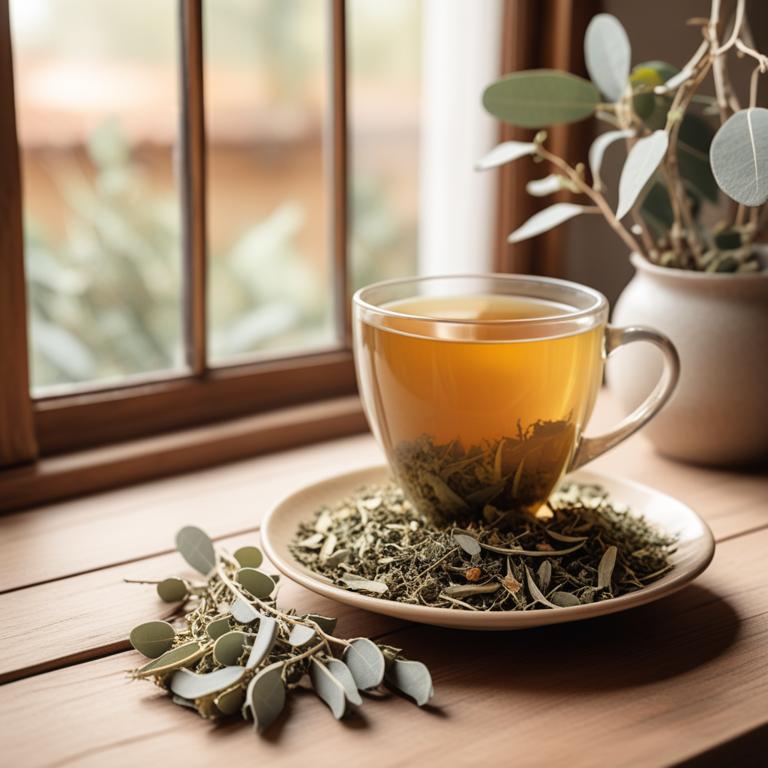
Eucalyptus globulus teas have been traditionally used to treat throat pain ailments due to their anti-inflammatory, decongestant, and soothing properties.
The bioactive constituents present in these teas, including eucalyptol, cineole, and globulol, help to reduce inflammation and relieve congestion, thereby alleviating throat pain and discomfort.
By acting as a natural expectorant, Eucalyptus globulus teas help to thin mucus and promote its expulsion, making it easier to breathe and swallow.
Regular consumption of these teas can provide relief from throat pain and promote overall respiratory health, making them a popular herbal remedy for treating this ailment.
Related Study
According to "Journal of alternative and complementary medicine (New York, N.Y.)", Eucalyptus globulus teas, a component of Throat Coat, significantly reduced the intensity of throat pain when swallowing in patients with acute pharyngitis, providing a rapid and temporary relief of sore throat pain.
Recipe:
- Gather 1 cup of fresh eucalyptus leaves (Eucalyptus globulus).
- Chop the leaves into small pieces and add 1 tablespoon of honey.
- Heat 1 cup of water in a pot and bring it to a boil.
- Add the chopped eucalyptus leaves and honey to the boiling water.
- Let it steep for 5-7 minutes, then strain and drink as a warm tea.
Eucalyptus globulus teas can provide relief from throat pain due to its decongestant and anti-inflammatory properties, but it may also cause side effects such as stomach upset, nausea, or allergic reactions in some individuals.
To use Eucalyptus globulus teas safely, it is essential to drink it in moderation, avoid taking it if you have any underlying medical conditions, and be cautious when consuming it if you have sensitive skin or allergies.
Eucalyptus Globulus Tea on Amazon
Jovvily Eucalyptus Leaves - 1lb - Dried - Cut & Sifted - Herbal Tea
Disclaimer: We earn a commission if you click this link and make a purchase at no additional cost to you.
5. Sambucus nigra teas
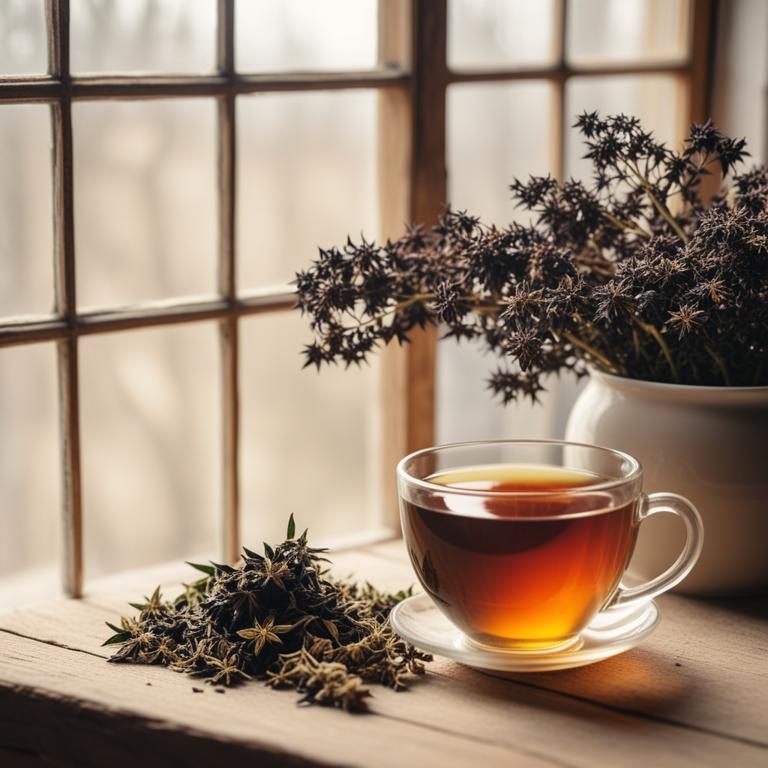
Sambucus nigra teas have been traditionally used to treat throat pain ailments, such as sore throats and laryngitis, due to their anti-inflammatory and antimicrobial properties.
The bioactive constituents of Sambucus nigra, including flavonoids, phenolic acids, and terpenoids, have been found to help reduce inflammation and combat infections that cause throat pain.
The antiviral and antiphlogistic properties of Sambucus nigra teas help to alleviate throat pain by reducing inflammation and fighting off viral and bacterial infections, making it a popular natural remedy for soothing sore throats.
Regular consumption of Sambucus nigra teas has been shown to provide long-term benefits in treating throat pain ailments, including reduced inflammation, improved immune function, and enhanced overall well-being.
Related Study
According to "Journal of alternative and complementary medicine (New York, N.Y.)", Sambucus nigra teas for throat pain were found to significantly reduce the intensity of throat pain when swallowing, with a rapid, temporary relief of sore throat pain in patients with pharyngitis, as demonstrated in a clinical trial where Throat Coat tea (containing Sambucus nigra) provided better results compared to a placebo.
Recipe:
- Gather 1 cup of fresh or dried Sambucus nigra flowers, or 2 tablespoons of dried flowers.
- Combine the flowers with 1 cup of boiling water in a saucepan.
- Reduce heat to a simmer and let it steep for 5-7 minutes.
- Strain the tea into a cup and discard the flowers.
- Drink the tea hot or let it cool down to soothe your throat pain.
Sambucus nigra teas can be used to treat throat pain, but possible side effects include allergic reactions, such as hives or itching, and interactions with other medications, like blood thinners or diabetes medications.
To use Sambucus nigra teas safely, take precautions to avoid allergic reactions by starting with a small dose and monitoring for any signs of discomfort, and also be aware of potential interactions with medications that you are already taking.
Sambucus Nigra Tea on Amazon
Elderberry Turmeric Ginger Tea - Made in USA
Disclaimer: We earn a commission if you click this link and make a purchase at no additional cost to you.
6. Lavandula angustifolia teas

Lavandula angustifolia teas, derived from the flowers of the lavender plant, have been traditionally used to treat throat pain and soreness.
The anti-inflammatory and antiseptic properties of this herbal preparation help to soothe and calm the throat, reducing inflammation and discomfort.
The bioactive constituents, including linalool and linalyl acetate, possess antimicrobial and anti-inflammatory properties that contribute to the effectiveness of Lavandula angustifolia teas in treating throat pain.
By consuming Lavandula angustifolia teas, individuals can experience relief from throat pain and discomfort, as well as other benefits such as improved sleep quality and reduced stress levels.
Recipe:
- Gather 1 cup of dried Lavandula angustifolia flowers.
- Measure 1 tablespoon of dried flowers and place them in a tea infuser.
- Boil 1 cup of water in a pot and let it cool for 1 minute.
- Steep the dried flowers in the hot water for 5-7 minutes.
- Strain the tea and drink it when it's warm, 2-3 times a day for throat pain relief.
Lavandula angustifolia teas can provide relief from throat pain, but possible side effects may include drowsiness, headaches, and allergic reactions in some individuals.
Precautions should be taken when using this herbal preparation, as it may interact with certain medications, such as blood thinners, and can exacerbate conditions like high blood pressure or epilepsy.
Lavandula Angustifolia Tea on Amazon
Tiesta Tea - Lavender Chamomile Herbal Tea | Loose Leaf | Calming Blend with Chamomile and Lavender | Caffeine-Free Herbal | Great for Hot or Iced Brews | Resealable Bulk Pouch, 200 Cups | 8 Ounce
Disclaimer: We earn a commission if you click this link and make a purchase at no additional cost to you.
7. Rosmarinus officinalis teas
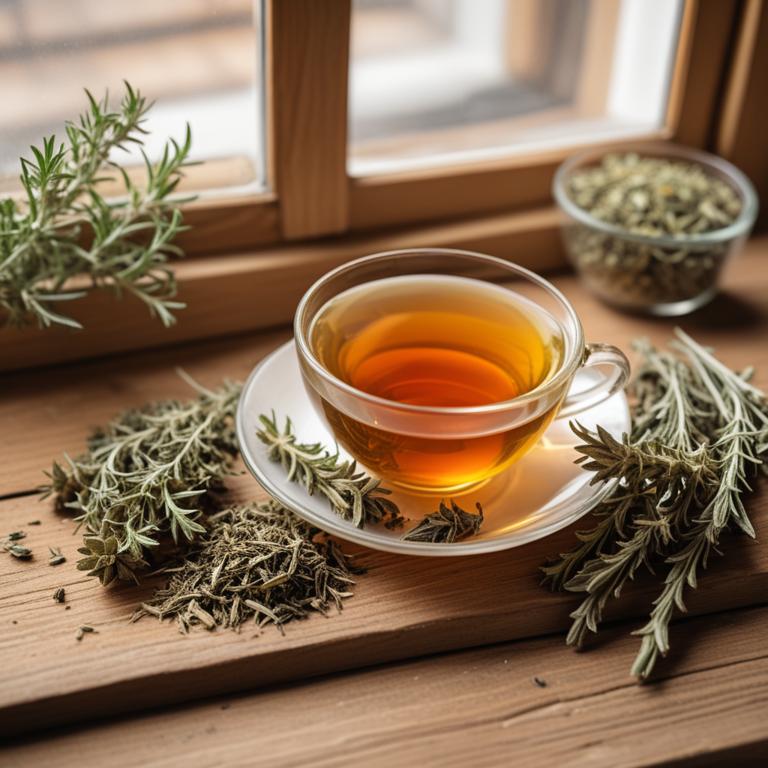
Rosmarinus officinalis teas have been traditionally used to treat throat pain ailments due to their anti-inflammatory and antimicrobial properties, which help to reduce swelling and combat infections in the throat.
The bioactive constituents present in these teas, including rosmarinic acid, carnosic acid, and camphor, contribute to their therapeutic effects by exerting antioxidant, anti-inflammatory, and analgesic properties.
Drinking Rosmarinus officinalis teas can provide relief from throat pain by reducing inflammation, soothing the mucous membranes, and promoting a healthy respiratory system.
Regular consumption of these teas is also known to have additional benefits, such as improving digestion, boosting the immune system, and reducing stress levels, making them a holistic approach to treating throat pain ailments.
Recipe:
- Gather 1 cup of boiling water and 1 tablespoon of dried Rosmarinus officinalis leaves.
- Measure 1 tablespoon of honey and keep it ready for later use.
- Steep the dried Rosmarinus officinalis leaves in the boiling water for 5-7 minutes.
- Strain the mixture into a cup and discard the leaves.
- Add the measured honey to the tea and mix well to sweeten it.
Rosmarinus officinalis teas can provide relief from throat pain, but some possible side effects include dizziness, headaches, and stomach upset due to its high concentration of volatile oils, which may interact with certain medications or exacerbate underlying health conditions.
To use Rosmarinus officinalis teas safely, it's essential to start with low doses, avoid consuming it on an empty stomach, and be cautious when driving or operating heavy machinery, as the herbal preparation may cause drowsiness or lightheadedness.
Rosmarinus Officinalis Tea on Amazon
Palm Beach Medicinal Herbs - Rosemary Tea - Pure Herbal Tea Series, 30ct
Disclaimer: We earn a commission if you click this link and make a purchase at no additional cost to you.